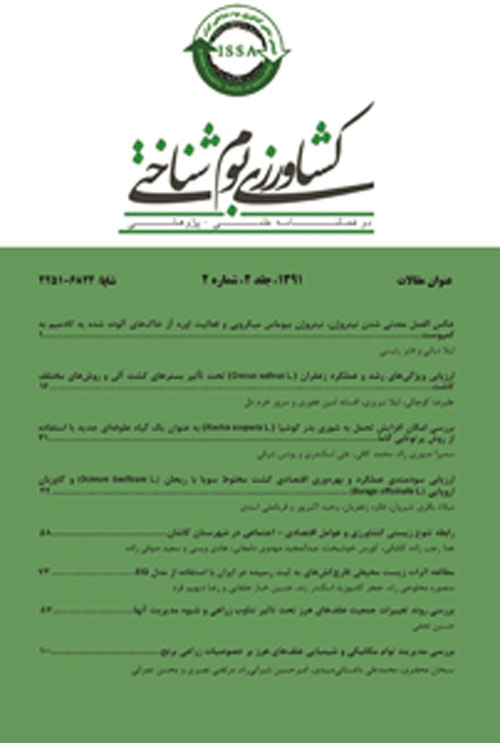Effect of bacterial biocontrol agents on common bean blight caused by Xanthomonas axonopodis pv. phaseoli
Author(s):
Abstract:
Introduction
Common bacterial bean blight with the casual agent of Xanthomonasaxonopodis pv. phaseoliXap) causes severe damage to the crop in the west of the country. The disease is prevalent in areas with warm weather, causing up to 80% yield reduction (Lak and Dorri, 2009). One of the ways to control the plant disease is to use bacterial biological agents such as Pseudomonasfluorescens and Bacillussubtillis. The aim of this study is to investigate the biological agents that control common bacterial bean blight disease.Materials And Methods
First, the growth inhibitory effect of bacterial biocontrol agents against Xap was investigated in vitro on the Nutrient Agar (NA)medium for 24 hours. Then the effect of biological agentsP. fluorescensB.subtilis, and the combination of them) against Xanthomonas axonopodis pv. phaseoli were evaluated in a completely randomized design in addition to four replications under greenhouse conditions. After about three weeks, indices such as fresh root and shoot weight, dry root and shoot weight, root and stem height, plant resistance, and the percentage of plant disease (according to the coding system ICTA and the method of Webster etal.,1983) were measured and used to analyse the control power of the biological agents.Results And Discussion
The results showed the biological agents prevented the growth of Xanthomonas axonopodis pv. phaseoli by creating a zone inhibitor in the NA medium. The diameter of zone inhibition for P. fluorescens and B. subtilis were respectively 32.75 and 20.75 mm. Zone inhibition indicated that the biological agents P. fluorescens and B. subtilis reduced by 20% and 30% Xanthomonas axonopodis pv. Phaseolis growth in the culture medium. The severity of Xanthomonas axonopodis pv. phaseoli symptoms on bean plants under greenhouse conditions were more than 63%, but the biological treatments reduced the symptoms and increased the plants strength. In this study, the combination of these two biological factors treatment (P. fluorescens B. subtillis) had the greatest biocontrol effects on the disease and reduced bean common bacterial blight symptoms up to 51% compared to the control. They converted the plant from susceptible to moderately resistant. Singular treatments of P. fluorescens and B. subtilis reduced symptoms up to 21.74% and 15.22% respectively. These changes in the weight and height of the plants infected by the biological agents Xanthomonas axonopodis pv. phaseoli had a significant effect on the one-percent significance level. It has been found that these biological agents can prevent the growth of plant pathogenic bacteria such as Xanthomonas axonopodis pv. phaseoli by the production of antibiotics, secondary metabolite (Raijmakers and Mazzola, 2012), direct impact on plant growth, production of auxin and cytokinin, and stimulation of plant resistance (Nejad et al., 2000; Kilian et al., 2000).Conclusion
These biological agents, such as P. fluorescens and B. subtilis, had a significant impact in preventing the growth of Xanthomonasaxonopodis pv. phaseoli. Thus, we could use these biological agents and their materials production to control common bean blight disease.Keywords:
Language:
Persian
Published:
Journal of Agroecology, Volume:7 Issue: 1, 2017
Page:
124
magiran.com/p1733929
دانلود و مطالعه متن این مقاله با یکی از روشهای زیر امکان پذیر است:
اشتراک شخصی
با عضویت و پرداخت آنلاین حق اشتراک یکساله به مبلغ 1,390,000ريال میتوانید 70 عنوان مطلب دانلود کنید!
اشتراک سازمانی
به کتابخانه دانشگاه یا محل کار خود پیشنهاد کنید تا اشتراک سازمانی این پایگاه را برای دسترسی نامحدود همه کاربران به متن مطالب تهیه نمایند!
توجه!
- حق عضویت دریافتی صرف حمایت از نشریات عضو و نگهداری، تکمیل و توسعه مگیران میشود.
- پرداخت حق اشتراک و دانلود مقالات اجازه بازنشر آن در سایر رسانههای چاپی و دیجیتال را به کاربر نمیدهد.
In order to view content subscription is required
Personal subscription
Subscribe magiran.com for 70 € euros via PayPal and download 70 articles during a year.
Organization subscription
Please contact us to subscribe your university or library for unlimited access!



